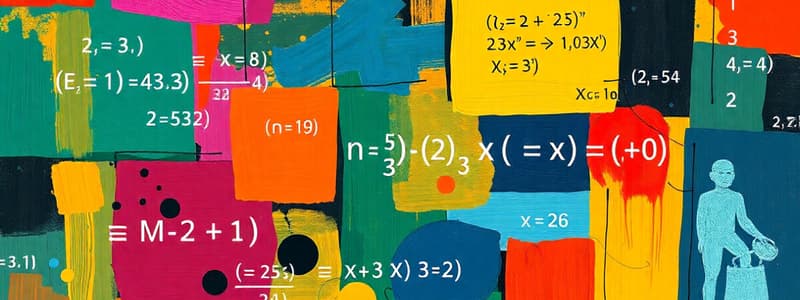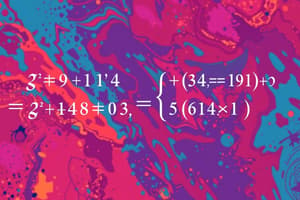Podcast
Questions and Answers
What is the result of evaluating the expression $3x + 4$ when $x = 2$?
What is the result of evaluating the expression $3x + 4$ when $x = 2$?
- 8
- 12 (correct)
- 10
- 14
Which property justifies the equation $2 + 3 = 3 + 2$?
Which property justifies the equation $2 + 3 = 3 + 2$?
- Distributive Property
- Inverse Property
- Associative Property
- Commutative Property (correct)
When adding integers -5 and 3, what is the correct process?
When adding integers -5 and 3, what is the correct process?
- Subtract the smaller absolute value from the larger and keep the sign of the larger. (correct)
- Subtract 5 from 3.
- Add the absolute values and keep the sign of the greater absolute value.
- Add the absolute values and take the positive sign.
What is the value of $a(a + 5)$ using the distributive property?
What is the value of $a(a + 5)$ using the distributive property?
Which of the following statements is true regarding multiplying integers?
Which of the following statements is true regarding multiplying integers?
Which of the following statements about solving equations is true?
Which of the following statements about solving equations is true?
What is the sum of the angles in a triangle?
What is the sum of the angles in a triangle?
Which of the following operations should be performed first according to the order of operations?
Which of the following operations should be performed first according to the order of operations?
Which of the following numbers is a prime number?
Which of the following numbers is a prime number?
If 25% of a number is 15, what is the number?
If 25% of a number is 15, what is the number?
Flashcards
What is an equation?
What is an equation?
A statement that shows two expressions are equal. Solving an equation means finding the value of a variable that makes it true.
How do you solve an equation?
How do you solve an equation?
The process of isolating a variable in an equation by using inverse operations.
What is the order of operations?
What is the order of operations?
A rule that determines the order of operations in a mathematical expression. It follows the acronym PEMDAS: Parentheses, Exponents, Multiplication/Division (from left to right), Addition/Subtraction (from left to right).
What are factors?
What are factors?
Signup and view all the flashcards
What are multiples?
What are multiples?
Signup and view all the flashcards
What is a variable?
What is a variable?
Signup and view all the flashcards
What is an expression?
What is an expression?
Signup and view all the flashcards
What are integers?
What are integers?
Signup and view all the flashcards
What is the rule for multiplying integers with different signs?
What is the rule for multiplying integers with different signs?
Signup and view all the flashcards
Study Notes
Introduction to Pre-Algebra
- Pre-algebra is a foundational step toward learning algebra.
- It builds on arithmetic concepts and introduces basic algebraic principles.
- It strengthens critical thinking and problem-solving abilities.
- Topics include working with variables, solving equations, and fundamental geometric ideas.
Variables and Expressions
- Variables are symbols (like 'x' or 'y') representing unknown quantities.
- Expressions combine variables, numbers, and mathematical operations (addition, subtraction, multiplication, division).
- Evaluating expressions involves substituting values for variables and calculating the result.
- Example: If x = 5, then 2x + 3 = 2(5) + 3 = 13.
- Mastering the order of operations (PEMDAS/BODMAS) is critical for correct expression evaluation.
Properties of Numbers
- Commutative property: Changing the order of addends or factors doesn't alter the sum or product. (a + b = b + a, ab = ba)
- Associative property: Changing the grouping of addends or factors doesn't alter the sum or product. ((a + b) + c = a + (b + c), (ab)c = a(bc))
- Distributive property: Multiplying a sum by a number is the same as multiplying each addend by the number and adding the products. a(b + c) = ab + ac
- Identity property: Adding zero to a number or multiplying a number by one doesn't change the number. (a + 0 = a, a × 1 = a)
- Inverse property: Adding a number and its opposite equals zero. Multiplying a number by its reciprocal equals one. (a + (-a) = 0, a × (1/a) = 1, assuming 'a' is not zero)
Integers
- Integers are whole numbers and their opposites, including zero.
- Positive integers (e.g., 1, 2, 3) are greater than zero.
- Negative integers (e.g., -1, -2, -3) are less than zero.
- The number line helps visualize the order of integers.
- Operations on integers (addition, subtraction, multiplication, and division) follow specific rules.
Operations with Integers
- Adding integers with the same sign: Add the absolute values and keep the sign.
- Adding integers with different signs: Subtract the smaller absolute value from the larger absolute value and use the sign of the larger.
- Subtracting integers: Change subtraction to addition and add the opposite of the second integer.
- Multiplying or dividing integers with the same sign: The result is positive.
- Multiplying or dividing integers with different signs: The result is negative.
Solving Equations
- Equations state that two expressions are equal.
- Solving an equation means finding the variable's value that makes the equation true.
- The goal is isolating the variable on one side of the equation using inverse operations.
- Example: To solve x + 5 = 10, subtract 5 from both sides to get x = 5.
Introduction to Geometry
- Fundamental geometric shapes include points, lines, and planes.
- Angles and their measurements.
- Types of angles (acute, obtuse, right, straight).
Order of Operations (PEMDAS/BODMAS)
- Parentheses/Brackets
- Exponents/Orders
- Multiplication and Division (from left to right)
- Addition and Subtraction (from left to right)
Factors and Multiples
- Factors of a number are whole numbers dividing the number evenly.
- Multiples of a number are products of the number and whole numbers.
- Prime numbers have only two factors, 1 and themselves.
- Composite numbers have more than two factors.
Fractions
- Fractions represent parts of a whole.
- Understanding equivalent fractions, comparing fractions, and ordering fractions.
- Addition, subtraction, multiplication, and division of fractions.
- Mixed numbers and improper fractions.
Decimals
- Decimals represent parts of a whole using a base-10 system.
- Converting between decimals and fractions.
- Comparing decimals and ordering decimals.
- Addition, subtraction, multiplication, and division of decimals.
Ratio and Proportion
- Ratios compare two quantities.
- Proportions are equations showing equal ratios.
- Solving proportions to find unknowns.
Percentages
- Percentages represent parts of a whole as hundredths.
- Converting between percentages, decimals, and fractions.
- Calculating percentages.
- Finding the percentage of a number.
Studying That Suits You
Use AI to generate personalized quizzes and flashcards to suit your learning preferences.




